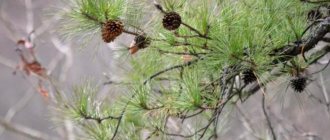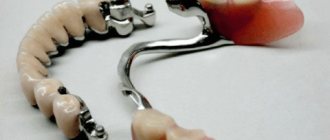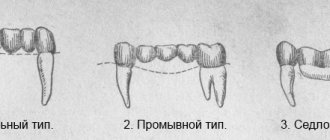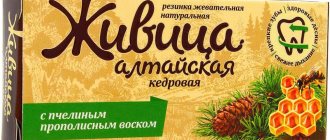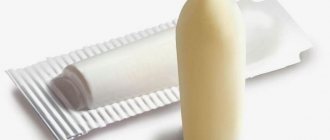An analogue of regular chewing gum is chewing sulfur or, in other words, resin chewing gum. In the process of manufacturing such a product, resin from coniferous trees, in particular larch, is used. This product is rich in vitamins and minerals, and all because it is natural and environmentally friendly. The substance is very viscous and is released in large volumes. Such chewing gum has a number of advantages and disadvantages, which will be discussed in this article.
This product can be used many times. If you don't chew it, store it in a jar of water. When liquefying the wax in your mouth, you can make it harder by breathing in a little air.
What is chewing sulfur and how is it made?
The composition of coniferous wood includes resin, which is a bactericidal agent that heals damage and wounds to the trunk, and has many useful properties. It flows out of every crack formed in the bark. The benefit of resin for wood is to protect it from fungal infections and prevent drying out. Because of its healing properties it is called resin. There are several types of gum resin, which are cut from different trees. Each has its own beneficial properties:
- ointments are made from spruce resin to treat skin diseases;
- cedar - used for preparing balms and tinctures;
- the benefit of pine is that it treats colds and strengthens the immune system;
- Leafy properties are used to improve oral health.
Chewable sulfur has a beneficial composition made from tree resin and essential oil. Until the oil evaporates, the resin is in a liquid-viscous form, but after evaporation it hardens. The same thing happens to resin as a result of exposure to wind and sun: it turns into a yellow or white crystalline substance, forming growths on trees. They can be carefully cut with a knife without harming the bark.
To use sulfur as a useful chewing gum, it is mined during logging. The growths are cut from felled trees. Then they are heated in an oven or on fires, packaged and sold. The disadvantage of tar melted over a fire is that it does not harden and sticks to the teeth. However, it does not lose its beneficial properties. Sulfur melted in the oven hardens and retains the shape of a lump. To chew it, you need to hold the resin in your mouth for a while until it softens.
Advice! Chewing sulfur should be stored in a jar of cold water, which prevents it from drying out and helps preserve its beneficial properties.
Chewing gum harm
Now let's talk about the disadvantages that await a person who is accustomed to chewing tasty gum after every meal.
You need to know when to stop. When using chewing gum to cleanse the oral cavity of microorganisms, it is necessary to observe moderation. Chewing gum is enough to chew for five to ten minutes to carry out superficial cleaning of the oral cavity and activate the secretion of salivary secretions.
If you neglect this rule and chew gum frequently, you may encounter the following problems:
- dysfunction of the stomach and duodenum due to excessive formation of gastric juice;
- weakening of the dental periodontium, because teeth are not designed for continuous chewing;
- disturbances in the functioning of the temporomandibular joint, headaches;
- abrasion of tooth enamel, change in its color;
- formation of gastritis and ulcers;
- increased degree of dryness of the oral mucosa.
Education of addiction
If a person chews gum every time a stressful situation arises, he will get used to this state of affairs. In any situation, even the simplest one, he will resort to chewing gum.
Poisonous effect
Chewing gum many times a day for long periods of time can make a person feel nauseous. If you chew gum for a long time, then food debris that the gum “collects” can get into the stomach, which is also very unpleasant.
Harm to the mouth
Chewing gum too often on one side of the jaw (right or left) leads to external asymmetry of the face. The reason for this is an increase in muscles on only one side of the jaw. Excessive activity on one side of the mouth compared to the other can lead to the development of oral diseases.
Harm to children
The use of chewing gum in childhood and even adolescence is fraught with disruptions and complications in the development of teeth. Chewing gum, especially when blowing bubbles, significantly spoils the bite and contributes to the incorrect positioning of teeth.
Harmful components
If chewing gum contains harmful components, then the negative effect of its use increases significantly.
Sugar in chewing gum promotes the formation of dental caries. Dyes, flavor stabilizers, some emulsifiers and antioxidants harm the human liver and cause intestinal problems. Phenylalanine, found in some chewing gums, harms the functioning of the nervous system. Some sugar substitutes can negatively affect the functioning of blood vessels and the digestion process. These include sorbitol, aspartame, acesulfame.
So, after familiarizing yourself with all the pros and cons of chewing gum, you can make the right decision - how often you can use it. Chewing gum is just a pleasant addition to a whole range of measures that must be taken daily to keep your smile beautiful and your teeth healthy.
Composition of chewing sulfur
The benefits of sulfur for chewing directly depend on its composition. The resin, which is the basis of pine chewing gum, contains useful:
- groups of vitamins A, B, C, E, P;
- carotene;
- iron;
- calcium;
- phosphorus;
- iodine;
- diterpene and fatty acids.
We recommend reading: Is Doshirak harmful, the benefits and harms of instant noodles
Chewable sulfur is a natural product that does not contain flavorings, dyes, food additives, sweeteners, or preservatives, which significantly increases its benefits.
How resin is collected
Previously, resin was collected like this: two deep cuts were made on the tree with a sharp instrument at an angle to each other (mustache). The surface of the trunk intended for cutting is called a karra, the part of the surface on which the cuts are applied is called a karra mirror, and the untouched strip of bark between the karras is called a belt. In the middle of the carra, a longitudinal (guide) groove of about 1 meter is drawn with a rounded cutter, which is cut with grooves at an angle of 45 degrees. The resin flowed along the grooves into the guide groove and from there into the receiver.
Collection of coniferous tree resin, 1957
Despite the fact that industrial procurement of cedar resin has been going on in Russia for 90 years, in Buryatia, sulfur was traded everywhere until the 2000s. After the collapse of the Soviet Union, people survived thanks to the ability to collect it and sell it. In the 2000s, industrial production of larch sulfur began to develop, subject to sanitary conditions and quality control, and the sale of this product on the street ceased. In Ulan-Ude today there are several enterprises that produce resin in four stages: collecting larch bark, melting the resin from the bark, cleaning the resin and packaging.
Tar production today
Benefits of chewing sulfur for the body
The benefits of larch sulfur for the body are high. This is a strong antiseptic created by nature, which:
- helps relieve inflammation;
- strengthens and supports the immune system;
- protects the body from viral infections;
- normalizes acid-base balance;
- improves the digestion process;
- normalizes blood circulation;
- increases the elasticity and firmness of the walls of blood vessels;
- reduces blood sugar levels;
- protects the body from the influence of cigarette smoke, the smell of paint, gasoline and exhaust gases;
- Helps overcome nicotine addiction and suppress the craving for smoking.
Important! Chewing sulfur is an indispensable remedy during epidemics of viral and infectious diseases and influenza.
Chewing tar, due to its beneficial properties, has a positive effect on dental health. It can be used for preventive purposes as a remedy against periodontal disease, caries, and tartar. The healing properties of sulfur strengthen and heal gums. It whitens tooth enamel, freshens breath and disinfects the oral cavity. Chewing gum made from pine needles is a good analgesic. Therefore, it can be chewed for toothaches.
Chewable tar against smoking
When quitting carousing, cigarettes are often replaced with chewing gum. Replacing it with sulfur helps you get rid of nicotine addiction faster, without causing absolutely any harm to the stomach and other organs. The beneficial substances contained in tar remove nicotine and carbon monoxide from the body. To get the benefits of pine gum for lung recovery, it will take 2 to 3 months.
Chewable sulfur for weight loss
Chewing tar is good for weight loss because its bitter pine taste discourages the false feeling of hunger, which causes many people to take quick, high-calorie snacks. This makes oleoresin much healthier than regular chewing gum, the sweetish taste of which, on the contrary, provokes a feeling of hunger and also harms the stomach and teeth. But chewing sulfur alone will not help you lose weight. This requires a properly structured diet and willpower.
Recommendations before use
Taiga tar or chewing gum made from resin is very sensitive to temperature changes. Therefore, it is best to keep it in warm water before chewing. You can also just put a piece in your mouth and warm it there. Well, then start chewing.
In fact, chewing gum made from larch resin is a natural antiseptic that destroys most bacteria in the oral cavity. It is great for people suffering from diabetes, as it contains no sugar. And for everyone else, chewing gum and tar will not hurt. Does not cause allergies.
Indications for use of chewing gum
Chewing sulfur is good for preventing oral diseases. Experts also advise chewing it for inflammation, gastrointestinal disorders, and to normalize digestion. The use of healthy resin is recommended:
- for children to form the correct bite;
- diabetics, as it has the property of stimulating blood circulation and lowering blood sugar;
- for the prevention of heartburn and other stomach disorders;
- use instead of toothpaste outside the home;
- with constant dry mouth;
- with inflammation of the gums;
- for toothaches;
- as a breath freshener;
- to normalize blood circulation: pine chewing gum helps relieve tension and fatigue, therefore it is recommended for use by drivers.
We recommend reading: Why palm oil is harmful, photos and reviews
The absence of chemical additives in its composition enhances the benefits of chewing sulfur for the body and minimizes harm. Therefore, the product is absolutely safe even if accidentally swallowed.
History of resin use
Cedar resin was used back in Ancient Greece - it was used for digestive disorders, as well as for the treatment of kidney and lung diseases, rheumatism and skin diseases.
In the Middle Ages, they learned to make turpentine from resin - with the help of its vapors, which had bactericidal properties, they were saved from the plague. Healing resin has been used since ancient times and in Chinese folk medicine as a universal remedy for many diseases, especially for toothache and headaches. In Rus', the resin of coniferous trees was actively used as a medicine: pine, spruce, fir, cedar and larch. It is the larch, according to the belief of many Buryats, that is a symbol of life and is directly related to human life. People turned to her, begging for children, longevity, and health. To do this, they found a strong, strong larch tree, tied a ribbon around its trunk, lit a lamp and, walking around the tree several times, asked for the wish to come true.
Cedar resin
It is for their healing properties that these resins are popularly known as “resin,” that is, “life-bearing.” In the scientific world they are better known as turpentine . One of the most famous surgeons in history, Nikolai Ivanovich Pirogov, who lived in the 19th century, used cedar resin as an antiseptic after amputations and difficult operations. Pirogov wrote a work on the properties of resin based on his clinical works and observations.
The first industrial harvesting of cedar resin took place in the Altai Mountains in 1932. This natural remedy was used by military surgeons during the Great Patriotic War when there was a shortage of medicines to treat bullet wounds, protecting them from infection or the development of a gangrenous process.
How to use chewing sulfur correctly
Before chewing hard sulfur, it must be softened by holding it in the mouth for some time. In this condition, it can be applied to the inflamed or swollen gum. In the same way, you can treat wounds in the mouth and relieve toothache. It is not recommended to chew sulfur on an empty stomach; it is better to do it 5 - 10 minutes after eating. Before chewing, rinse your mouth thoroughly.
In order not to cause harm to the gums instead of the expected benefit, you should not use oleoresin when they are bleeding. Prolonged chewing will further worsen the symptoms because it promotes blood flow to the gums.
Use in folk medicine
Larch oleoresin is widely used in folk medicine:
- For cracked lips, it is necessary to apply this product to the problem area for 3-5 days. It softens well and promotes wound healing.
- For catarrh and stomach ulcers, for dysbacteriosis, it is used orally in small volumes. In this case, the oleoresin is dissolved one pea at a time on an empty stomach before meals.
- For furunculosis, this remedy is applied to a clean piece of cotton cloth and applied to the sore spot. The pain goes away almost immediately, and within a few days this problem disappears.
- Weeping eczema is treated by applying this remedy to the affected areas.
- For cough and bronchitis. It is recommended to infuse the “sulfur” in a glass of water for 24 hours. The resulting liquid is drunk in 3 doses per day.
- For sore throat and inflammation in the throat, resin is absorbed within 24 hours. This will quickly improve the condition.
- For hemorrhoids, use an ointment based on larch resin.
- To soften and remove calluses, corns, and heal cracks on the soles of the feet, resin is also used, which is fixed to problem areas with a plaster.
Possible harm and contraindications for use
Having a lot of useful properties, chewing sulfur still has some contraindications and can cause harm to the body. But this happens in rare cases.
It is not recommended to use resin:
- with periodontal disease;
- in case of personal intolerance to the components included in its composition;
- if you are allergic to the aroma of pine needles;
- during smoking: the ability of tar to quickly absorb carcinogens leads to them entering the stomach along with saliva.
Therefore, it is worth remembering that, even with great benefits, chewing resin can in some cases cause harm to the body.
Why useful tar comes from Buryatia
In Buryatia, coniferous forests predominate (75%), of which almost half are larch (48%), there are also pine (16%) and cedar (9%). The most widespread is the Dahurian larch (Larix gmelinii), which is called the “hero of the taiga”, because it grows in the very north, in the permafrost zone. She is not afraid of strong winds, she has powerful roots, and is resistant to rot. In Eastern Siberia, in the area of Lake Baikal, Siberian larch (Larix sibirica) grows. It is from such larches that resin is extracted and Buryat chewing gum is produced - Baikal tar.
Not only in physical, but also in medicinal properties, larch is not inferior to pine and cedar. Irkutsk scientists obtained from its ingredients a powerful medicine - diquertin , which today is widely used for the prevention of various diseases.
Resin in the form of candies
Advantages and disadvantages
Chewing sulfur has a huge number of benefits:
- By consuming oleoresin between meals, you not only cleanse your mouth of remaining food particles, but also freshen your breath;
- the resin also strengthens teeth and gums, providing an anti-inflammatory effect; accordingly, this is an excellent method for the prevention of diseases of the teeth, gums and oral cavity;
- the product prevents many diseases, such as caries, periodontal disease, gingivitis, stomatitis, and the formation of tartar;
- has a beneficial effect on the digestive system;
- helps to gently whiten teeth, making them more snow-white;
- oleoresin helps to neutralize and protect the body from the negative effects of harmful factors, such as paint, the smell of gasoline or exhaust gases, tobacco smoke;
- eliminates bad breath even after foods such as garlic and onions; tar also protects you from harmful microorganisms that contribute to the development of viral diseases;
- Helps strengthen the overall human immune system.
The product is absolutely harmless and is even recommended for use by small children instead of regular chewing gum. In children, oleoresin helps to train the chewing muscles, because the resin is much more difficult to chew than ordinary chewing gum and in order to chew it it is necessary to apply force.
Even if a small child accidentally swallows such chewing gum, no unpleasant consequences will occur, since the resin is an absolutely natural product and does not cause irritation to the child’s stomach or intestines.
